|
|
Because of their stationary lifestyle and growth habit, fungi are often thought to be plants. They aren't.
Fungi cells have walls that contain chitin, unlike the cell walls of plants which contain cellulose. In that respect, fungi are more closely related to animals than plants. Even so, fungi are classified in a Kingdom of their own - Fungi, which is separate from Plants, Animals, and Bacteria.
There are two groups of fungi. These are the microfungi (fungi which are too small to be seen with the naked eye) and the macrofungi, which are the fungi that can be seen without the aid of a microscope. Macrofungi include the familiar mushrooms, puffballs, stinkhorns, bracket and coral fungi.
Macrofungi, in turn, have been classified into smaller divisions. Three of the main divisions are:
|
|
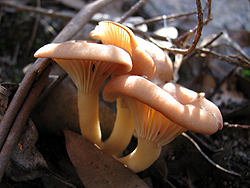
A macrofungi found near the Bald Rock Creek camping area.
|
| Ascomycetes |
or Sac Fungi. They are called this because they produce their spores inside a special cell called an "ascus". This is the largest division of fungi with 64,000 species world-wide. Amazingly, all these different fungi can trace back to having one common ancestor. Familiar examples of Sac Fungi include lichens, truffles, brewer's yeast and baker's yeast, powdery mildews and cup fungi.
More on Girraween's Sac Fungi species...
|
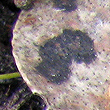
|
| Basidiomycetes |
or Club Fungi. They are called this because they produce their spores on the outside of a special club-shaped cell called a "basidium". This very large group of fungi includes the familiar mushrooms, puffballs, stinkhorns, jelly fungi, smuts, rusts, and some yeasts.
More on Girraween's Club Fungi species...
|
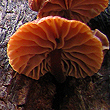
|
| Myxomycetes |
or Slime Moulds. Slimes Moulds aren't true fungi, but actually belong to the Kingdom of Protozoa. They are traditionally studied with fungi because their fruiting bodies are usually fungal in appearance. There are over 900 species of Slime Moulds world-wide. These organisms have a very unusual life cycle, part of which is quite animal-like.
More on Girraween's Slime Moulds...
|
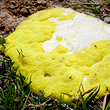
|
The macrofungi that we are used to seeing are actually only the fruiting parts of the organism - much like an apple on a tree.
The fungus itself is usually hidden away and looks like a tangled mass of tiny threads, like cotton wool. This fungal mass is called the "mycelium". The threads are usually white in colour, but may be black or blue, brown or even red. These threads, called "hyphae", penetrate the material – the "substrate" – in which the fungus is growing. This may be soil, wood, mulch, leaf litter, or even animal dung. The hyphae produce enzymes which breaks down the substrate into chemicals which the fungus can then absorb as food. Some of the chemical foods are used for further growth; some are stored away for later use.
When the fungi has enough energy stored away and the weather conditions are right, it will produce a fruiting body, which in turn, produces and releases tiny spores. If a spore should land in a suitable place, it will germinate and grow into another fungus.
Mycologists (scientists who study fungi) use spores to help identify a fungus' species. The fruiting bodies of many fungi may look alike - such as the typical white-capped "mushroom" - but their spores can be quite different. Some spores are round, some oblong, others are smooth, while others still have tiny spikes on them! Many Australian fungal species haven't yet been studied, described or even named. In 2004, the number of estimated Australian species was 20,000 and, at that time, only about a quarter of that number had been documented.
Fungi have many roles in the environment. Here are the top four:
|
|
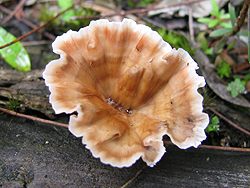
Above and below: the fruiting bodies of some of Girraween's wood-growing fungi.
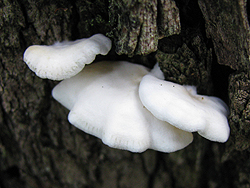
|
| Symbiotic Fungi |
Many fungi have close relationships to plants. The fungal hyphae and plant rootlets work together in what is called a "mycorrhizal association". The fungus receives carbohydrates and protection from the plant; the plant gets an enhanced supply of minerals and water from the soil via the fungus. It has been estimated that at least 85% of plants have a mycorrhizal association with a specific fungus and without their fungal partner, these plants would not survive. In Australia, such species include the Eucalypts, Acacia, Casuarina and many orchids.
|
| Saprotrophic Fungi |
These are the fungi which break down and recycle organic matter, releasing vital nutrients such as carbon and nitrogen back into the soil. They can be found in the bush on dead trees, fallen branches and leaf litter. Some species grow on animal dung and old bones.
|
| Parasitic Fungi |
These fungi are harmful to their host by causing disease and even death. They have a necessary role in controlling population growth. Some of these fungi attack plants, while others parasitize insects and other arthropods. Some species, after killing their host, continue to live as a saprobe by feeding on the dead material.
|
| Fungi are Food |
In Australia, fungi are a major component of many native animals' diet. Some of these animals are possums, wallabies, bettongs, bandicoots, wombats, skinks and birds. Many insects, mites, snails and slugs also eat fungi.
Not much is known about which species of Australian fungi may be suitable for human consumption. Even though a fungus might look like an edible species from overseas, chances are that it is not! Sadly, over the years, a number of deaths have occured in Australia to people who have thought they had picked and eaten a "safe" mushroom from the field. Cultural traditions for identifying fungi do not apply to Australian fungi, nor do the traditional methods for removing toxins. All fungi in Australia, except those grown and marketed commercially, should be regarded as potentially poisonous - even deadly. |
|

